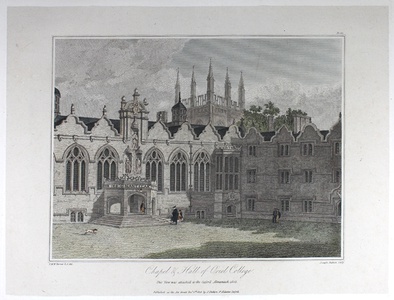| Method | Copper engraving with hand colouring |
| Artist | Joseph Skelton after J.M.W. Turner |
| Published | [Published as the Act directs, Decr. 2nd 1816 by J. Skelton, St. Aldates, Oxford.] |
| Dimensions | Image 180 x 235 mm, Plate 245 x 305 mm |
| Notes |
A reduced version of the Oxford Almanac for the Year 1801, from 'Oxonia Antiqua Restaurata' by Joseph Skelton. Skelton began publishing parts of this work from 1818 but it was not completed until 1820 and only fully published three years later in 1823. Joseph Skelton (1781 - 1850) was an English engraver of topographical and antiquarian subjects. He is best-known for his plates in 'Oxonia Antiqua Illustrata' (1823), 'Engraved Illustrations of Antiente Arms and Armour from the Collection at Goodrich Court from the Drawings, and with the Descriptions of Dr. Meyrick' (1830) (2 vols), and Girault's 'Les Beautes de la France' (1850). He settled in France in the latter part of his life and was elected FSA in 1844. His brother William Skelton was also an engraver. Joseph Mallord William Turner (1775 - 1851) was a painter and draughtsman who became one of the most celebrated artists Britain would ever produce. He was born near Covent Garden, London, and entered the Royal Academy Schools in December of 1789. The Academy, conscious of his prodigious talent, encouraged and supported Turner. He was elected as an Associate of the RA in 1799, and became a full Academician in 1802. His early oil painting flitted between Netherlandish works in the manner of Cuyp, Ruisdael and Van de Velde, classical landscapes like those of Claude and Richard Wilson, and, upon returning from his Parisian visit in 1802, grand historical compositions like those of Poussin and Titian. The development of his idiosyncratic style, commonly held to have been around 1803, led to critical condemnation. His preoccupation with light and colour produced abstract, near vorticistic works, which predated Impressionism, but were hugely controversial in the conformist context of late Georgian and early Victorian England. Whilst some critics accused Turner of extravagance and exaggeration, John Ruskin virulently thwarted these claims in Modern Painters, and championed the artist's fidelity to nature. Ruskin became the main advocate of a new generation of Turner admirers, usually professional, middle class, or newly wealthy, who embraced his work for its modernity. An enormously prolific artist, Turner bequeathed over three hundred oils and close to twenty thousand drawings and prints to the nation. His style produced many imitators, but no rivals. |
| Framing | mounted |
| Price | £150.00 |
| Stock ID | 50577 |

